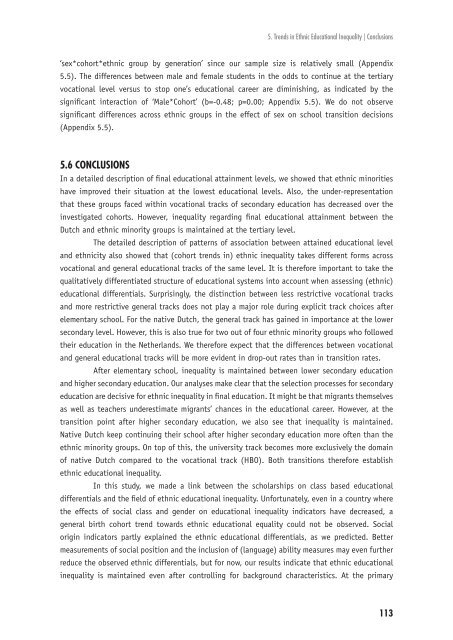Ethnic Hostility among Ethnic Majority and Minority Groups
Ethnic Hostility among Ethnic Majority and Minority Groups
Ethnic Hostility among Ethnic Majority and Minority Groups
You also want an ePaper? Increase the reach of your titles
YUMPU automatically turns print PDFs into web optimized ePapers that Google loves.
5. Trends in <strong>Ethnic</strong> Educational Inequality | Conclusions<br />
‘sex*cohort*ethnic group by generation’ since our sample size is relatively small (Appendix<br />
5.5). The differences between male <strong>and</strong> female students in the odds to continue at the tertiary<br />
vocational level versus to stop one’s educational career are diminishing, as indicated by the<br />
signifi cant interaction of ‘Male*Cohort’ (b=-0.48; p=0.00; Appendix 5.5). We do not observe<br />
signifi cant differences across ethnic groups in the effect of sex on school transition decisions<br />
(Appendix 5.5).<br />
5.6 CONCLUSIONS<br />
In a detailed description of fi nal educational attainment levels, we showed that ethnic minorities<br />
have improved their situation at the lowest educational levels. Also, the under-representation<br />
that these groups faced within vocational tracks of secondary education has decreased over the<br />
investigated cohorts. However, inequality regarding fi nal educational attainment between the<br />
Dutch <strong>and</strong> ethnic minority groups is maintained at the tertiary level.<br />
The detailed description of patterns of association between attained educational level<br />
<strong>and</strong> ethnicity also showed that (cohort trends in) ethnic inequality takes different forms across<br />
vocational <strong>and</strong> general educational tracks of the same level. It is therefore important to take the<br />
qualitatively differentiated structure of educational systems into account when assessing (ethnic)<br />
educational differentials. Surprisingly, the distinction between less restrictive vocational tracks<br />
<strong>and</strong> more restrictive general tracks does not play a major role during explicit track choices after<br />
elementary school. For the native Dutch, the general track has gained in importance at the lower<br />
secondary level. However, this is also true for two out of four ethnic minority groups who followed<br />
their education in the Netherl<strong>and</strong>s. We therefore expect that the differences between vocational<br />
<strong>and</strong> general educational tracks will be more evident in drop-out rates than in transition rates.<br />
After elementary school, inequality is maintained between lower secondary education<br />
<strong>and</strong> higher secondary education. Our analyses make clear that the selection processes for secondary<br />
education are decisive for ethnic inequality in fi nal education. It might be that migrants themselves<br />
as well as teachers underestimate migrants’ chances in the educational career. However, at the<br />
transition point after higher secondary education, we also see that inequality is maintained.<br />
Native Dutch keep continuing their school after higher secondary education more often than the<br />
ethnic minority groups. On top of this, the university track becomes more exclusively the domain<br />
of native Dutch compared to the vocational track (HBO). Both transitions therefore establish<br />
ethnic educational inequality.<br />
In this study, we made a link between the scholarships on class based educational<br />
differentials <strong>and</strong> the fi eld of ethnic educational inequality. Unfortunately, even in a country where<br />
the effects of social class <strong>and</strong> gender on educational inequality indicators have decreased, a<br />
general birth cohort trend towards ethnic educational equality could not be observed. Social<br />
origin indicators partly explained the ethnic educational differentials, as we predicted. Better<br />
measurements of social position <strong>and</strong> the inclusion of (language) ability measures may even further<br />
reduce the observed ethnic differentials, but for now, our results indicate that ethnic educational<br />
inequality is maintained even after controlling for background characteristics. At the primary<br />
113












